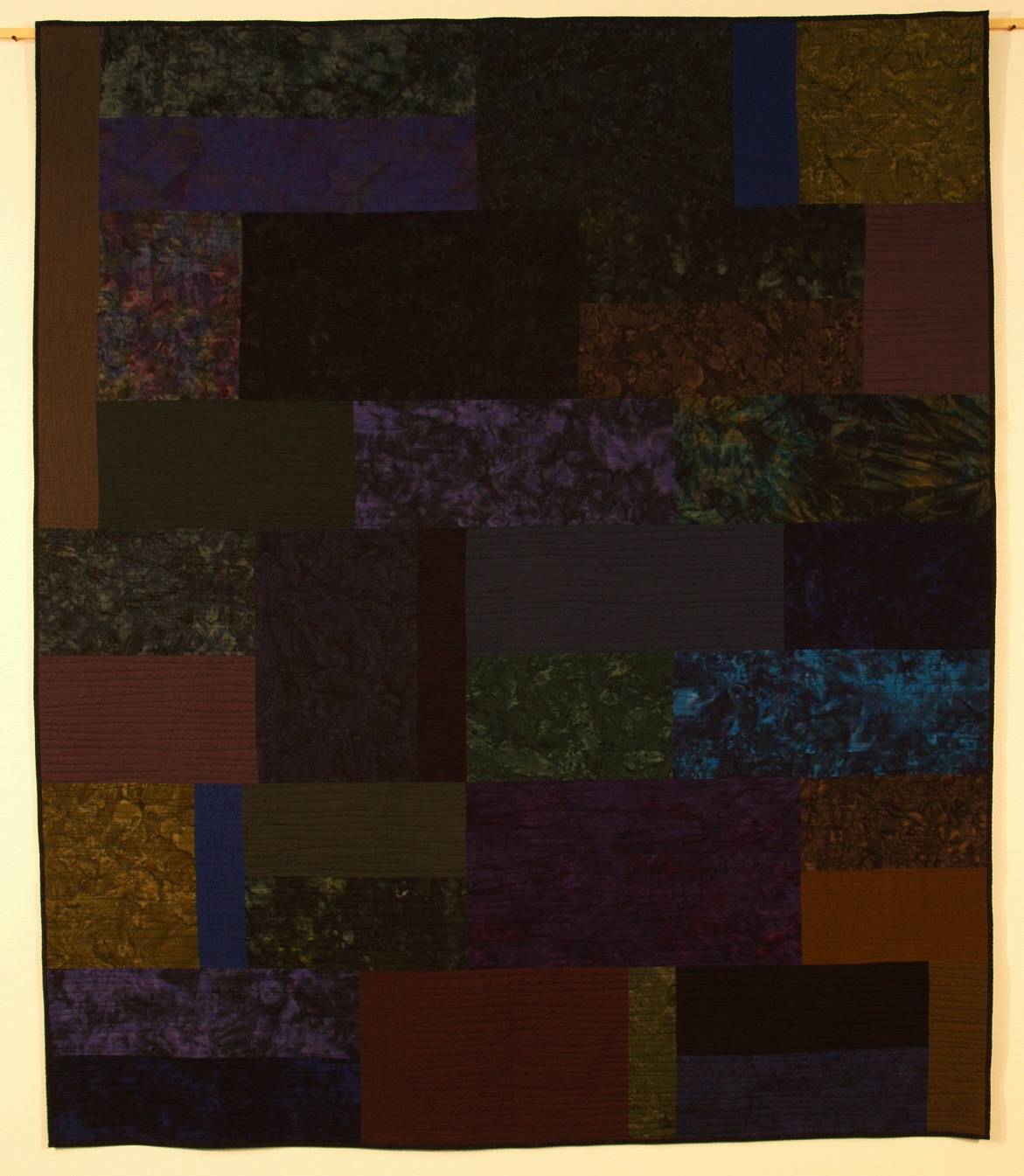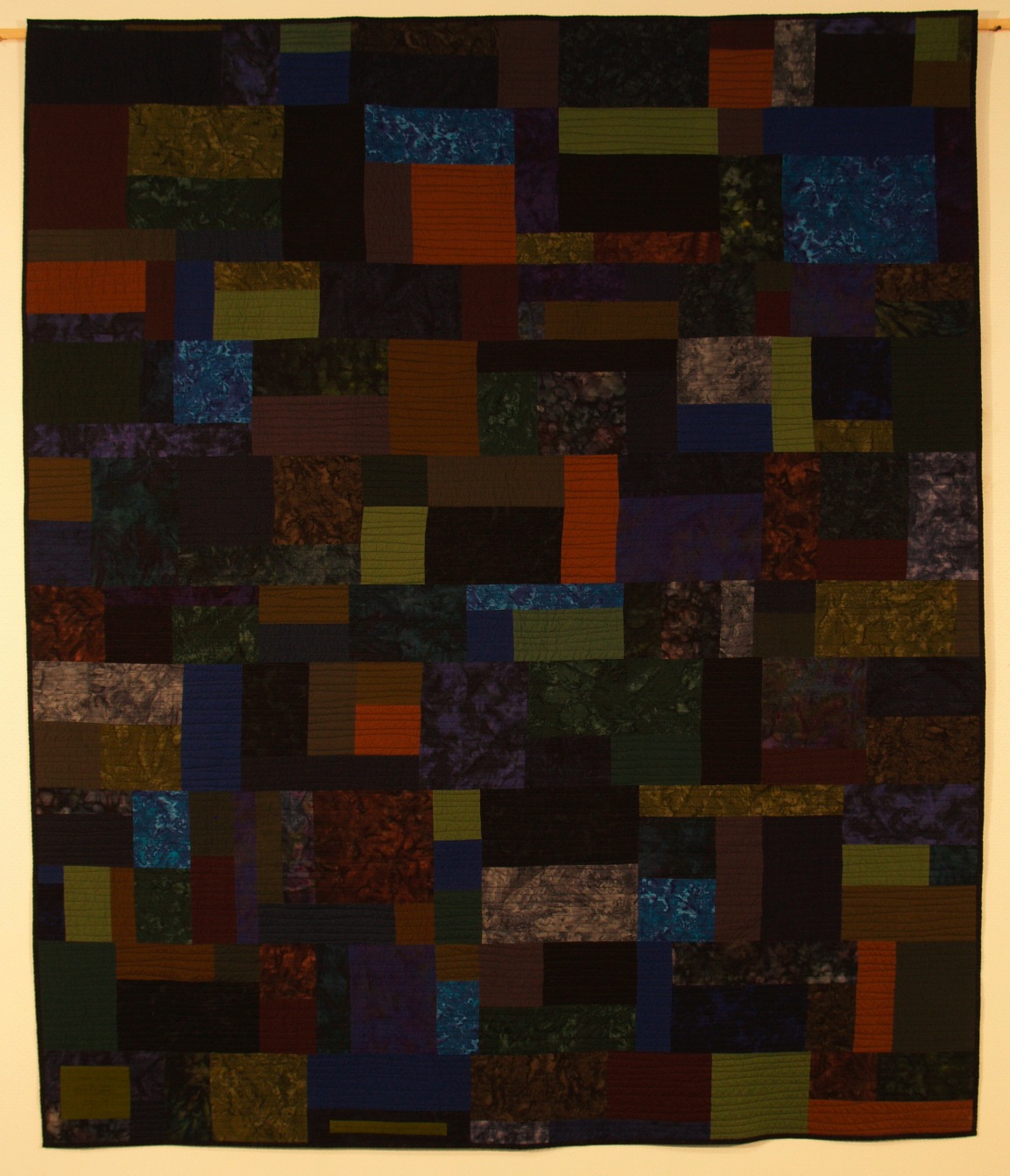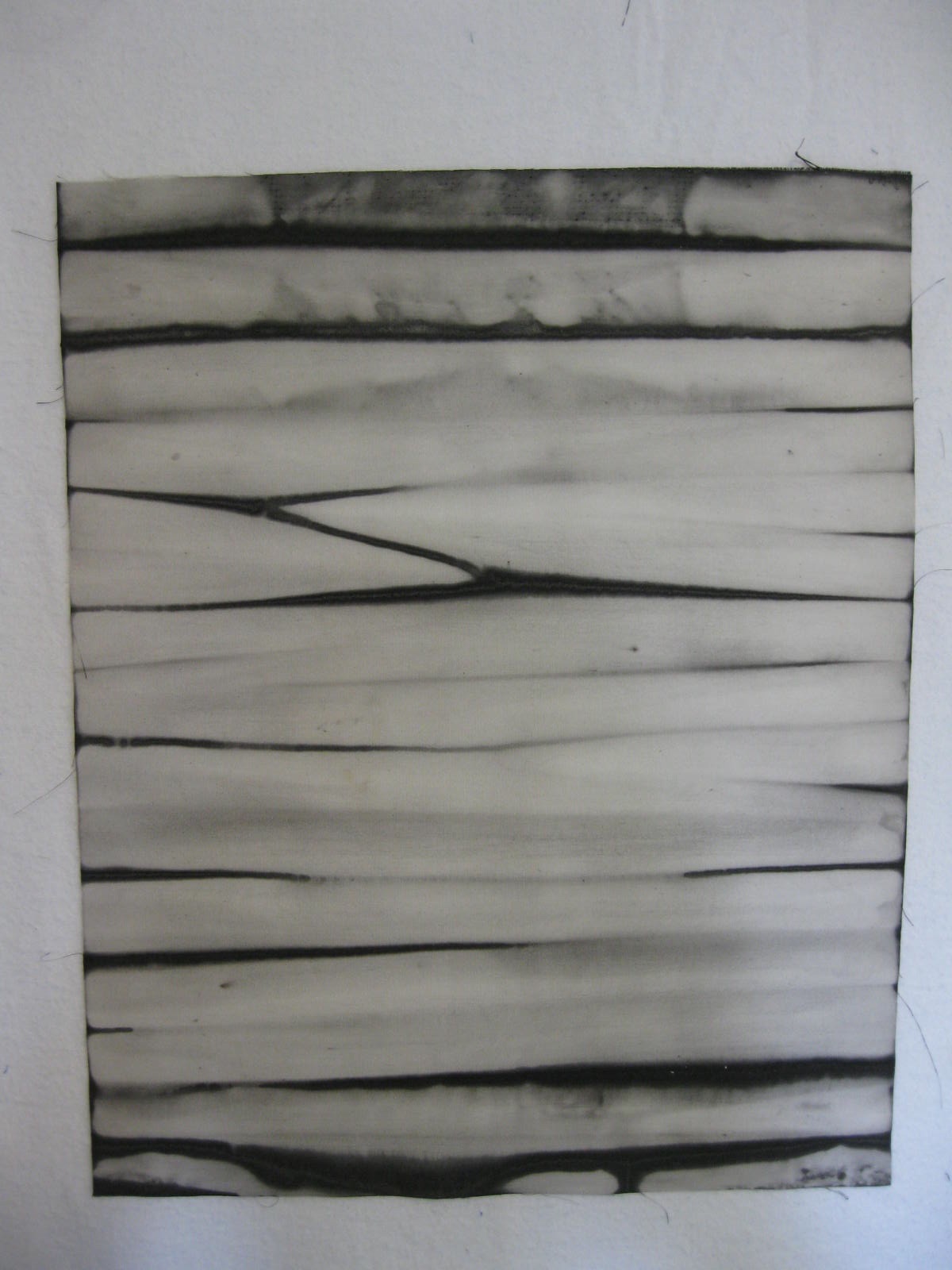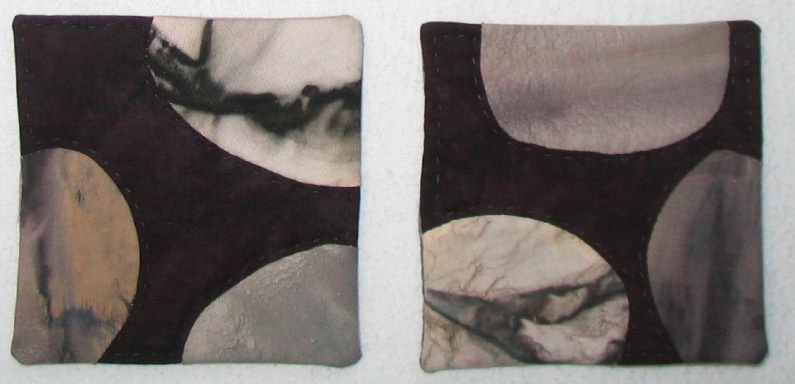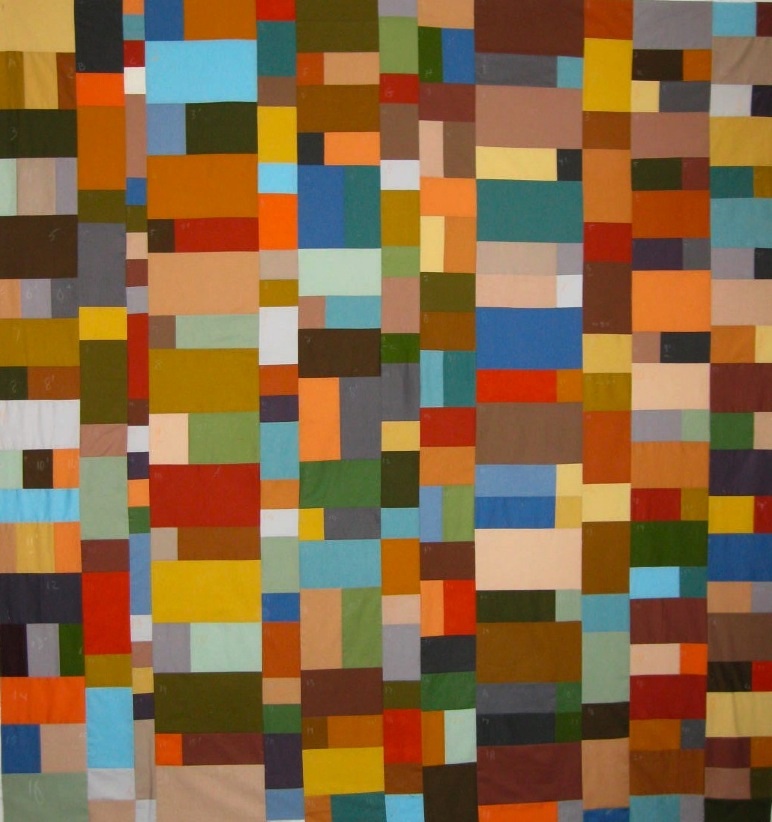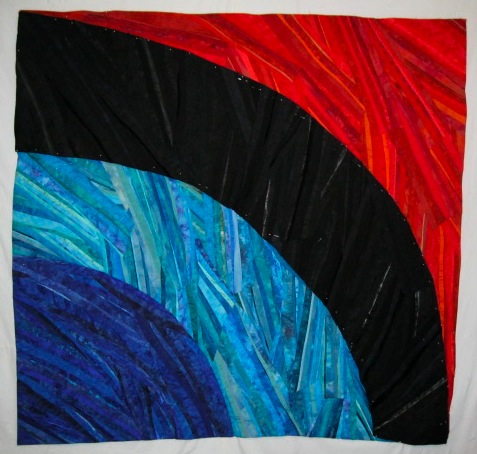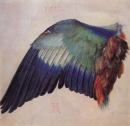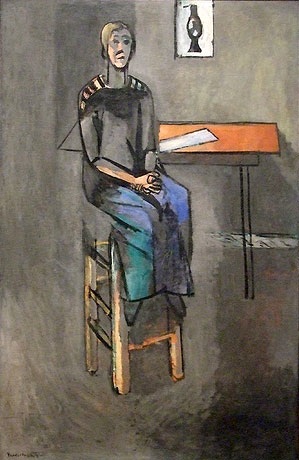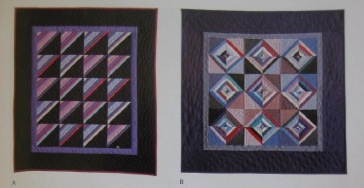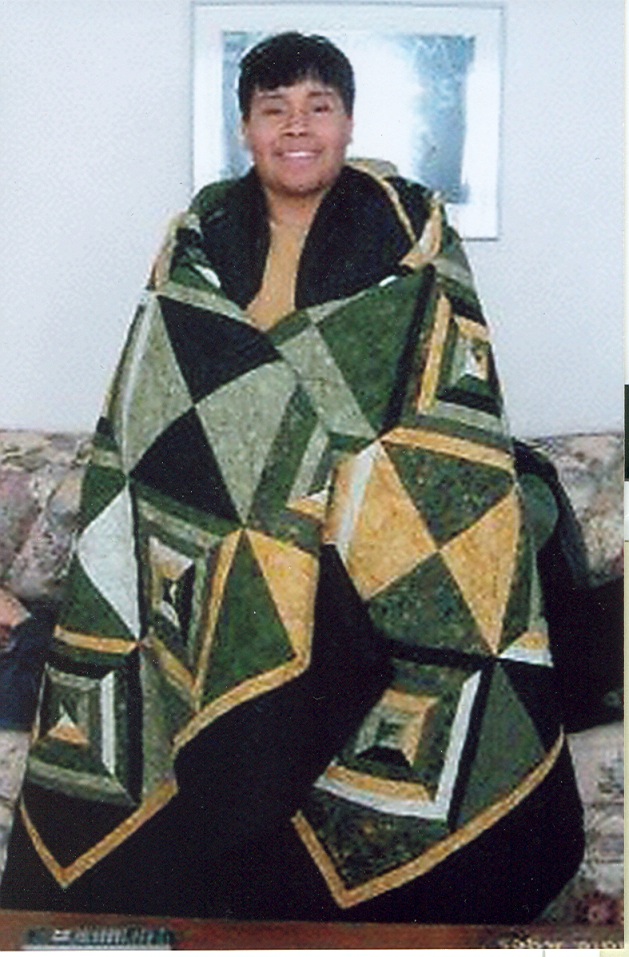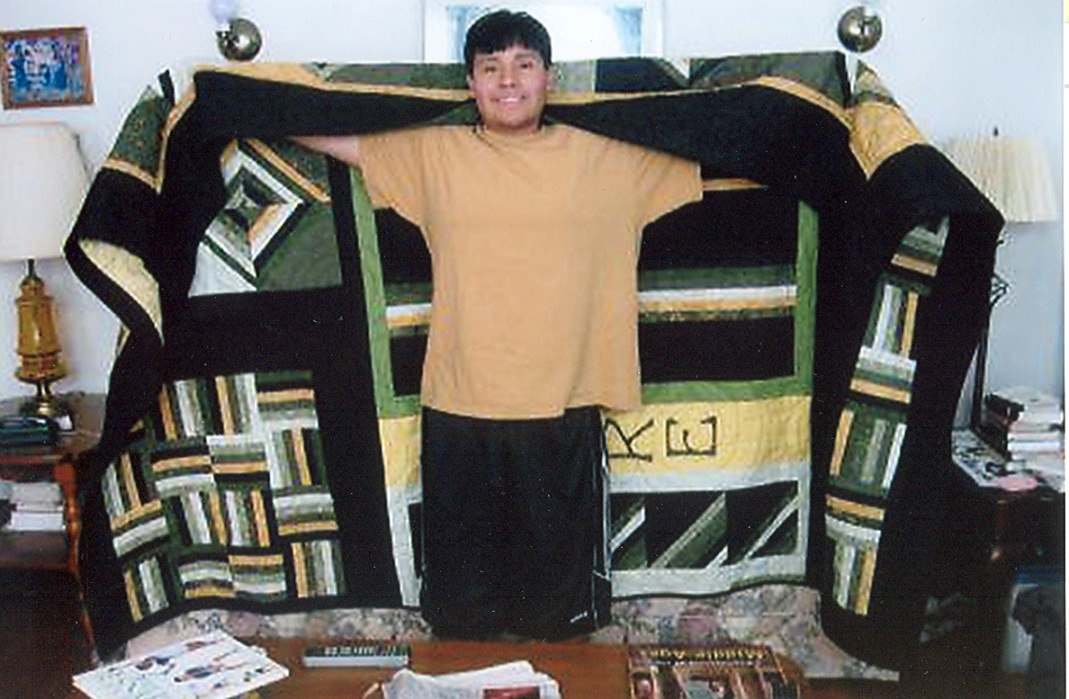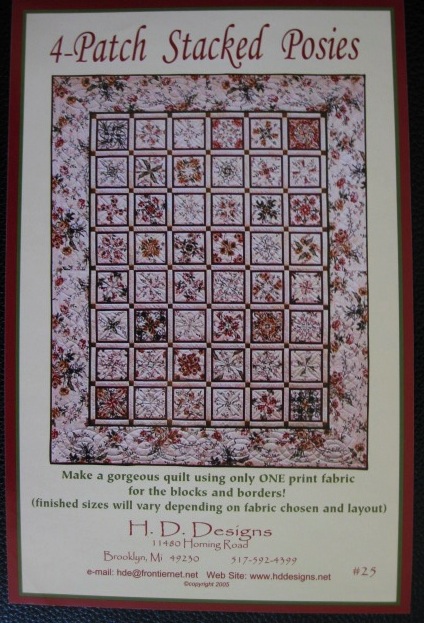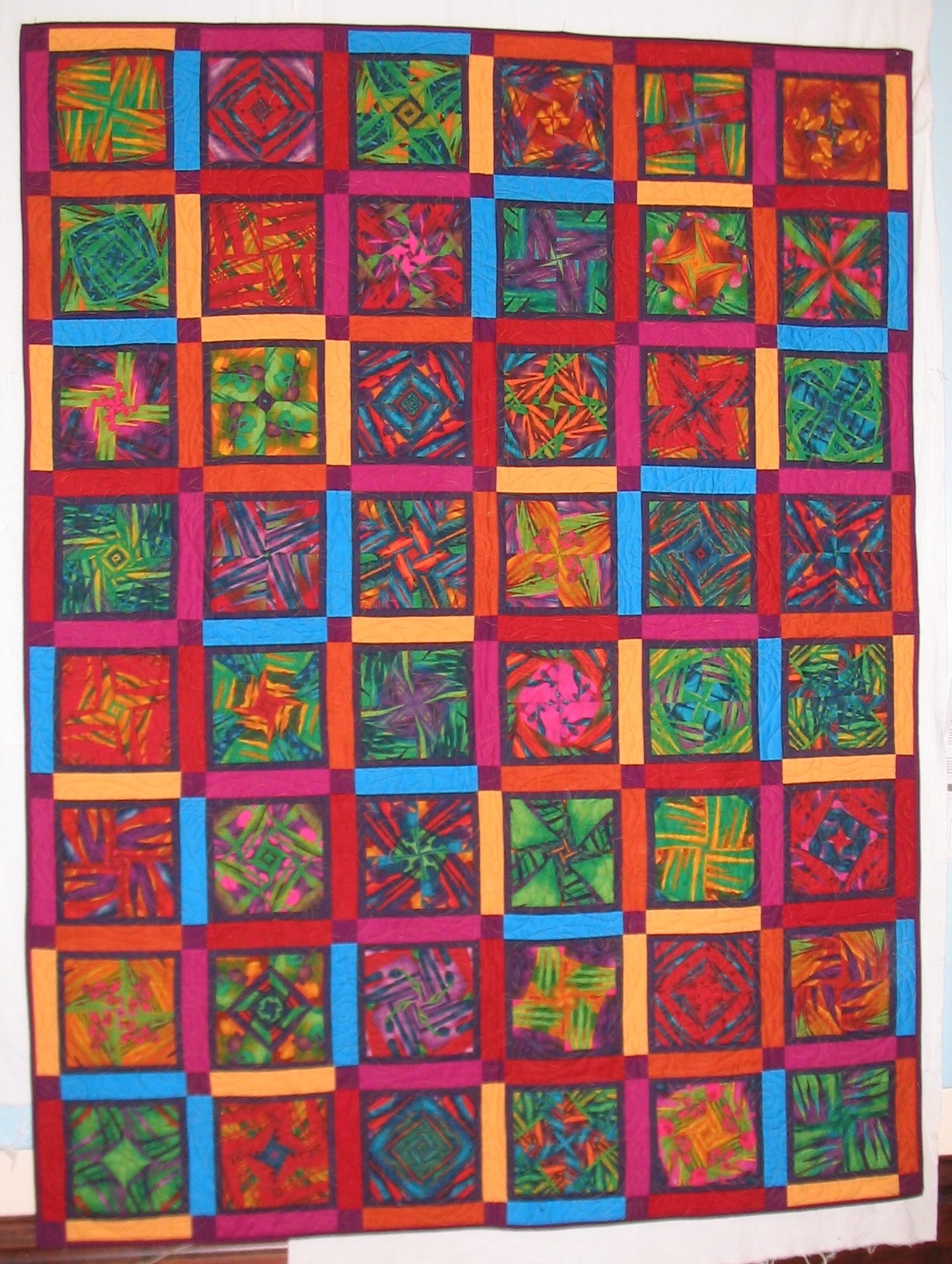FROM STUDY TO STUDIO:
MEANING AND MOTIVATION IN SCHOLARSHIP AND ART
Penny S. Gold
Presentation in the "Friday at Four" series of faculty work in progress
Knox College, Galesburg, Illinois
April 30, 2010
For many years, this desk was the focal point of my study, the place
where I wrote books, where I did my scholarship. My laptop sat on
the pull-out typing return. Detailed chapter outlines were tacked
to the bulletin board. The room was filled with books and files
connected to my job, to my professional life. It was a good place
to work. Thirty-plus years produced, among other things, these
four books:
In the summer of 2005, I abandoned work on a fifth book, and I
dismantled the study. I took out all the books and files. I
emptied the desk. I moved in my sewing machine, fabric, thread,
and tools. I changed my study to a studio. The words come
from the same Latin root, meaning "to pursue eagerly." Yes, I
pursued scholarship eagerly for over thirty years. Now that same
eagerness is going into the making of art. This is the story of
how scholarship came to have a central place in my life, why I stopped
doing research, and how I came to do something else. It's
not easy for me to tell this story publicly, but in this setting of the
community that has given me so much support along the way, I find
myself wanting to explain what happened to me.
I was an indifferent student through most of college. But in the
fall of my senior year, I happened into a medieval history class, along
with another on the history of culture and a third on cultural
anthropology. I was hooked. I quickly applied to graduate
school, but I had no idea what I was in for. I had never done a
significant research paper and knew nothing about professional
scholarship. I was interested in what medieval people wrote, not
in what modern scholars wrote about them. My first graduate
courses were a rude awakening to professional training. But
happily, I discovered the key to making scholarship a meaningful
endeavor for me—which was to choose a research question that
connected up with concerns in my personal life. This way, the
research really mattered to me—I was highly motivated to find
answers to the questions I posed. And so was launched the
research that occupied me for a dozen years, through the dissertation
and the book that followed, The Lady and the Virgin: Image, Attitude, and Experience in Twelfth Century France, the topic of women
in twelfth-century France reflecting my deep involvement in the women's
movement of the 1970s. This book is still in print after 25
years, and still being cited. My other
major work of scholarship, Making the Bible Modern: Children's Bibles and Jewish Education in Twentieth-Century America, looked at the
production and use of children's Bibles in Jewish education in
twentieth-century America, a project that helped me figure out
issues of Jewish identity in the modern world and about the education
of Jewish children, issues in which I was also engaged on a personal
level. In both books, the central question took me far afield to
find answers.
In both these books, I took a cultural practice and examined
multiple contexts that could help make sense of it. For the Bible
project, I not only pored over the dozens of Bible story books for
Jewish children, but also read deeply in the history of public
education in America, Protestant religious education, the ideology of
democracy between the wars, narrative theory, children's literature,
the history of biblical interpretation and of Jewish education, and the
development of Reform Judaism. I loved this process of exploring,
pushing boundaries, persisting until I could put together enough pieces
of the contextual puzzle that I could say, "now I understand it."
Now I'm going to back up and give you a parallel account of the place in my life of making things.
I have loved making things since I was a child, mostly needlework of
one sort or another, beginning with knitting a doll blanket. I
learned knitting, sewing, crocheting, embroidery--all from my
mother. It was a large part of my relationship to her.
Knitting has been the mainstay.
Why have I knit all these years? I enjoy the feel of
knitting--the repetitive motion, the contact with the yarn, the
satisfaction of seeing a garment or afghan grow from the work of my
hands. Most of what I knit is done in a very simple stitch so
that I don't have to look at the work, allowing me to knit in
situations where my attention needs to be directed elsewhere, as shown
in this photo taken at a city council meeting.
The results of the knitting are gratifying too, providing hand-made
gifts for many people in my life. I rarely knit for myself.
For most of my life, I never gave any thought to quilting. It was
not something my mother did, and learning from her was how I learned
needlework. But in the spring of 2001, Rick Ortner's young
daughter Katie, whom I had previously taught to knit and sew, asked if
I could teach her to quilt. (Rick was a long-time member of the
art faculty at Knox, leaving here in 2003.) Spurred by Katie's
interest, I checked out a pile of books from the public library and
learned enough to begin. Katie and I together made this quilt, a
pattern called Cathedral Window.
(Holding the quilt are two Knox quilters, Claire Rasmussen and Claire Leeds, both '03.)
I found I enjoyed quilting and set about learning various techniques,
which I did by making a succession of small projects, first potholders,
then placemats, and on to small wall-hangings.
Much as I was enjoying this new hobby, I was also frustrated by the
greater challenges presented by quilting. The challenge is
this: there are many, many more choices to make in
quilting. In knitting, I'd choose a pattern, select a color from
the limited range of yarns available, and follow the directions.
In quilting there are choices to make every step of the way, even when
using a pattern. While my ability to use color, value, and shape
improved through the many small projects, I was very aware of how much
I did not know about design, especially color and composition.
In 2004, I had enough confidence to undertake a bed-sized quilt—a
quilt for my son to take with him to college. We chose a log
cabin design, in his favorite color, blue. These are some of the blocks.
Jeremy was to
begin college in the fall of 2004, and I wanted the quilt finished by
then. I had almost all the blocks done by the beginning of the
summer.
And then Jeremy died.
For a week or so, the dark chasm that loomed on all sides was kept at
bay by the round-the-clock presence of family and friends. But
then one has to step back into the routine of life, and I found this
very difficult. Because it was summer and I wasn't teaching, my
days were unstructured by work. The scholarly research I had
planned to do was of no interest to me. Reading, which had always
been such a large part of my life, was also of no interest. One day it
occurred to me that sewing might help me pass the time—the days
were so long. I went over to the corner where I kept various
projects, and found some small appliqué blocks that I had
entirely forgotten about, all set to be sewn. It
turned out this was just what I needed to help me through the
day.
The soft colors, simple shapes, and the hand-sewing itself
were calming, and they kept my mind occupied in a way that helped keep
at bay images of Jeremy's accident and of his dead body.
The blocks were quickly finished, but I needed another project like
this. The sewing was a kind of analgesic, almost an anesthetic. I lined up another project, this
time going even further into the hypnotic effect of repetition by
sewing again and again just one simple shape, a circle (about 47"x65").
With these projects, the reason I was quilting had changed. It
was not just a pleasurable pastime, resulting in gifts for friends, but
something I needed to do for my sanity, that I needed to do to get
through each day. And the resulting quilts were no longer
something I could give away. I needed them by me.
As I worked on the simple appliqué
pieces, I also considered what to do about the log cabin quilt I had
been making for Jeremy. How could I finish it, now that he was no
longer here to receive it? But how could I discard this quilt I
had been making for him? I finally thought of a way that I could
finish it, but embed in it my grief over his death. At the time
Jeremy died, I had only three blocks left to complete the forty-eight
that would make up the top. I
decided to change the design for the last three blocks, making them off
of a five-sided center, rather than off the four sides of a
square. When set into the diamond pattern Jeremy had chosen for
the layout of the blocks, the placement of the three final blocks
expressed for me the way in which his life had so abruptly gone off
course. I thought a lot about where to put the three blocks. I
put them together rather
than scattered through the quilt; towards the edge rather than in the
center; towards the bottom rather than the top; catching one's vision,
but not dominant.
At this point, I'm going to shift back to what was happening in my
scholarship—going back past July 2004 when Jeremy died, to the
winter of 2003, when I was in the final stages of completing my book
Making the Bible Modern. In mid-March 2003, the copy-edited
manuscript of this book arrived in the mail, with a deadline of three
weeks for final edits. My mother, in a nursing home here in
Galesburg, was in the very final days of her life, dying from lung
cancer. My father had died just three weeks before, after a long
decline from Alzheimer's. The press was understanding and
generous in their extension of the deadline, but if the book was to be
published, the task could not wait long. A month after my
mother's death, I picked up the manuscript again. Working out the final
nuances of prose gave me none of the usual pleasure. I wanted my
parents back and the book dead—this is how I felt.
Would there be another book after this one? I had been jotting
down ideas and gathering references for a next book since mid-way
through the book on Bible stories, and I had loved the feeling of a
book quietly developing in the background while another was on the
front burner. But with the index for Making the Bible Modern
completed in the fall of 2003, some months after the deaths of my
parents, I found I had no drive to begin a new project. Then, as
more time passed, and a sabbatical approached, it slowly seemed
possible that I might try again. So there it stood on my to-do
list for summer 2004—to go through the box of notes and
references I had accumulated, and see where it might take me.
And then Jeremy died. In the wake of his death, scholarly writing
left my life. The kinds of questions that fuel research and that are
answered through scholarly writing were no longer part of my mental
activity. I think scholarly work also became bound up in the
guilt inevitably felt by a parent whose child had died. All those
occasions I'd gone to conferences or been at my desk, instead of being
with Jeremy.
I returned to teaching, but not to scholarship. As Roger
Rosenblatt wrote, after the sudden death of his daughter: "I
found I could not write and didn't want to. I could teach,
however, and it helped me feel useful." Much of my time at
home was spent quilting—projects like the ones I've shown
you. Then my life took another turn, as the result of a workshop
I attended in June 2005. Most quilting workshops focus on
technique, with students replicating a quilt designed by the
teacher. In contrast, this was a week-long design workshop for
quilters. The teachers, Bill Kerr and Weeks Ringle, taught a
design process, not a specific technique or pattern. My hope was
that learning more about design principles would help me with the
innumerable choices of quilting.
To prepare for the workshop, we were supposed to come with three
possible ideas—memories of events, things we'd like to do in the
future. These prompts didn't work for me, so I turned to
something else of interest—the late winter Midwestern landscape.
But then it was June, Design Camp was a week away, and I realized I was
bringing with me only one idea, not the three they had asked for.
The weekend before the workshop, David and I went to Starved Rock State
Park. We had lots of time to talk, including sharing how bleak
the future seemed to both of us.

At one point in the weekend,
feeling the press of needing to come up with a third idea for the
workshop, I asked David for help. It immediately occurred to both
of us that our feeling of the future without Jeremy was something that
could be the central idea for a quilt. As we talked, thinking
together of a possible design, I sketched out our ideas—a mosaic of colors on the left, which would
represent the brief span of Jeremy's life with us, and a chasm of
unbroken black on the right, representing our future without him.
So, I arrived at Design Camp with two ideas, high expectations, a good
deal of fear, and uncertainty about what direction I would be taking
with a quilt. What I didn't know was the extent to which this
workshop would be a transformative event in my life.
On the first day of the workshop, we were given an exercise: to
do a maquette (a small model) about a place that has been important to
us. I chose a quiet, peaceful place at the summer camp I went to
for years as a child--a pine grove, by the lake, away from the cabins
and activities, a place you could go to be by yourself.
I got to work, but all I could come up with was this (about 12"x15"):
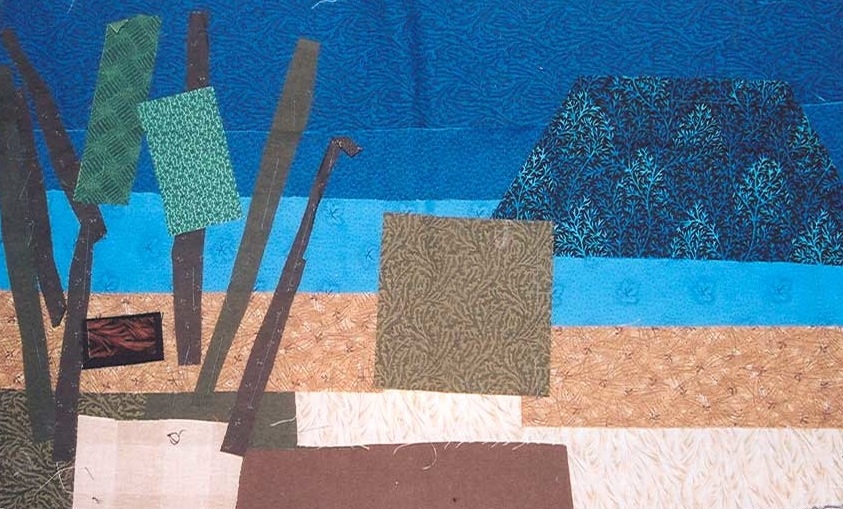
I was disappointed—even disgusted. I wanted
to do something that was totally abstract, that conveyed the peace and
quiet of the place without reference to specific objects like the
trees, shore, and water. But I had no idea how to do it.
When Bill came by to see how things were going, I was so upset with the
inadequacy of what I had done that I could barely speak, and I sent him
away. Once I composed myself, he came around again, and got me to
talk about the place, about what it was I wanted to convey. He
then asked me, "What was the opposite of that place?" I answered
that it was the hustle and bustle of all the group activities of the
camp—lots of things going on with lots of people. "Make a
maquette of that," he said. So I did.

This one I was happy with. I felt that I had captured
in color and line some sense of what I was aiming for—the
liveliness of the usual camp day. "OK," said Bill, "Now go back
to the pine grove." And so I made this:
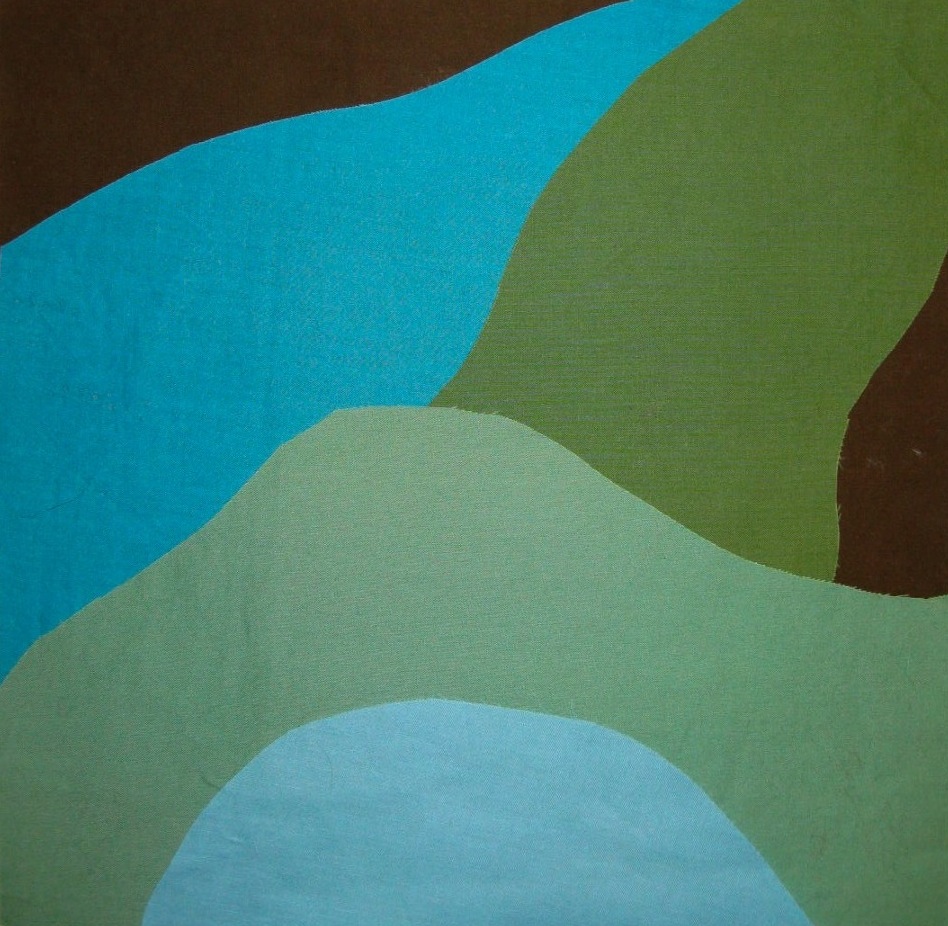
Yes, here it was, the feeling of the pine grove. Being able
to get to this abstract expression through the process of the exercise,
in one afternoon—this was amazing to me. I felt that
something was unlocked, that I could now do something I hadn't been
able to do before—or that I had reached into some well inside
myself that I hadn't known was there.
The next day, another exercise: to create a portrait, using color
in an abstract way to represent a particular person. Here it was,
an open door inviting me to work on a portrait of Jeremy, something
that could be the base for the multi-colored strip in the sketch David
and I had come up with.
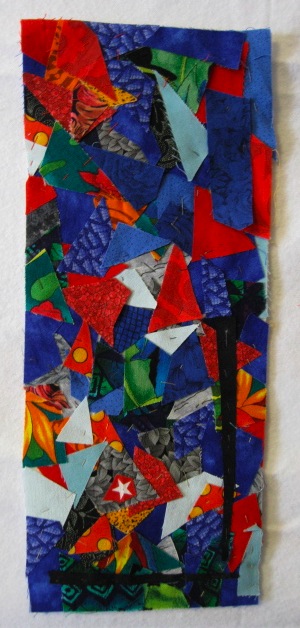
This portrait (about 4x12") came to me spontaneously,
without a struggle. It put something of Jeremy's character, and
about how I felt about Jeremy, into a visual form. The choices of
colors and shapes came easily because I had in mind the central idea I
wanted to express: that this was about Jeremy, about his energy
and intensity, about his sharp edges, about the problems as well as the
joys. That his life was varied, but also limited.
With the maquette of the mosaic side of the quilt already done, the
rest of the design came readily, putting the color of Jeremy's life
next to the blackness of our future. Here's a small maquette (15x16") of the full design:
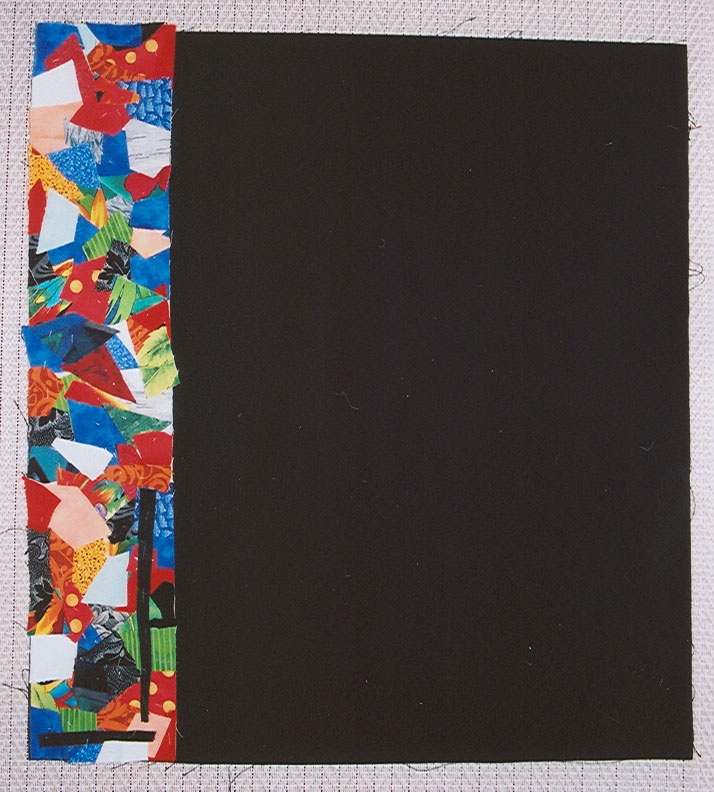
But there were still many questions of size, scale and
method. For example, just on the issue of how to sew the small
colored pieces onto the strip: Definitely by hand rather than
machine, but should the edges be raw or turned under? If raw,
should I allow the edges to fray? How big should the pieces
be? How much should they overlap, if at all? In the past, I would have been frustrated by all these
decisions--frustrated that I didn't know the "right" answer, not
knowing what would look best, and that I didn't know how to figure it
out. But with this project, I felt entirely
different. I was content to just keep at it until I had a method
that felt right.
Here's the difference: In all the quilting I'd done previously,
I'd begun with a design made by someone else. For each of the
subsequent decisions: fabric, color and value, border, binding,
quilting—for each of these I had only the guidance of wanting to
make something that would look nice, perhaps even beautiful. But
now I had begun a quilt with an idea of my own, an idea about which I
cared deeply. For every decision I faced, I had this idea to
guide me. It wasn't a question of what "looked best," but of what
best conveyed the idea I wanted to express. This principle of
using a central, originating idea as a generative source for a work of
art of course applies elsewhere as well; writings by Twyla Tharp,
the choreographer, have been helpful to me (
The Creative Habit), as well as Roger Sessions
on musical composition (
Questions about Music). Here is the completed quilt, called
"Loss."

(51"x58")
In the process of making this quilt, my reasons for quilting changed
again. I still had pleasure in doing the handwork. And it
still helped me to live with grief. But designing and making this
quilt also brought out into the world the expression of something I
felt, something for which words were inadequate (despite months of
intensive journal writing).
Making this quilt was a private endeavor. It's not
something that will ever be used on a bed or hung on a
wall. It has served as a kind of therapy for me. And
it has also become art—something with the potential of
communicating to others, even if that was not my original
intention. When I was at the design workshop, well along in
working on the quilt design, I brought the small maquette over to Bill
to ask him a straightforward technical question. Oddly, he didn't
respond. When I asked again, he said, "Penny, it's not so easy
for me to look at this. I have my own losses too." It
hadn't occurred to me that something so personal, so specific to me and
to David, could also strike this kind of chord in another person.
As I worked on this quilt, I wondered if I would have any ideas for
further quilts. The next one developed somewhat by accident,
several months after Design Camp. I offered to Rick
Ortner's son Peter that I would make him a quilt for a college
graduation present. Instead of choosing one of the patterns I
sent him, he asked, "How about something that feels aquatic or
subterranean, something dark with little gleams of light?" This
wasn't what I had had in mind, but I decided it would be an interesting
challenge to work with this as the central idea for a quilt, and I
collected fabric to bring to a second stint at Design Camp in
2006. As I got closer to working on the quilt, and considered how
much work would be involved in creating my own design, I thought it
might be a good idea to link up Peter's guiding notion with something
personal to me, something that might bring another level of meaning
into the quilt, and from which I would reap the personal benefit of
working through something that was disturbing me. As soon as this
occurred to me, I realized that I could link Peter's dark, subterranean
image with one of the images associated with Jeremy's death that I was
struggling with—the image of his body buried underground. I thought it possible that using this image for the
quilt, along with Peter's words, might serve to ease the grip of the
underground image for me. . . and it has.
(about 90 x 112")
And a detail that shows the quilting:
Here's the back of the quilt, which looks more
complicated, but was actually easier to do in terms of composition than
the larger pieces on the front.
Something more about the design process: My first maquette for
the quilt incorporated slivers of light-colored fabric to represent
stones (for me) and glimmers of light (for Peter). (In Jewish
practice, those who visit a grave place a small stone on the
gravestone, leaving behind a trace of their love and friendship.
I thought this personal meaning for me could work in line with
Peter's glimmers of light in the midst of darkness.) But when
I upped the scale for the quilt itself, the cloth slivers no longer
worked, and I
removed them from the design. In terms of Peter's idea, the
"glimmers of light" were still there, in the light portions of the
batik fabric. The idea of stones was set aside.
But I kept thinking about the stones. I tried several things
using commercial fabrics, either solids or fabric with stone-like patterns,
but none of them hit the mark. Here's one of those abandoned efforts (21x33").
The light gray section is the size of the headstone on Jeremy's grave,
and the dark gray band refers a layer of stones. I was not enough
moved by this to continue through to finishing it. It could be
that doing it either larger or smaller, rather than true-to-size, would
be better.
It became clear that commercial fabric was part of the problem, and I
decided to learn how to paint and dye my own fabric. I got the
confidence to try this by taking a summer workshop in watercolor and
pastel, in which I learned the principles of mixing color. I used watercolor to paint paper, which I
then cut up into stone-like shapes.
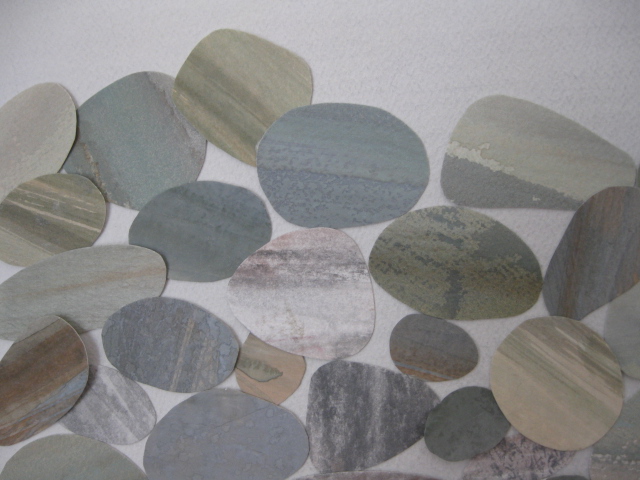
And
I used pastel to create a version of the Midwestern landscape I'd been
thinking about since Design camp.
(45 x 60")
I would like to make a cloth
version of this also, and am in the process of dyeing fabric to get the look I
want. The dyeing process is a significant challenge, but here's
why it's worth the trouble: a comparison of a commercial solid (on the right)
and a solid I dyed myself.
I've also painted and done monoprinting to make fabric that I could cut
up into stone-type shapes.
Some of this fabric has gone into small stone
portraits (each 4x4"):
I also took another
direction, putting aside the shape of stones and focusing instead on
color and texture .
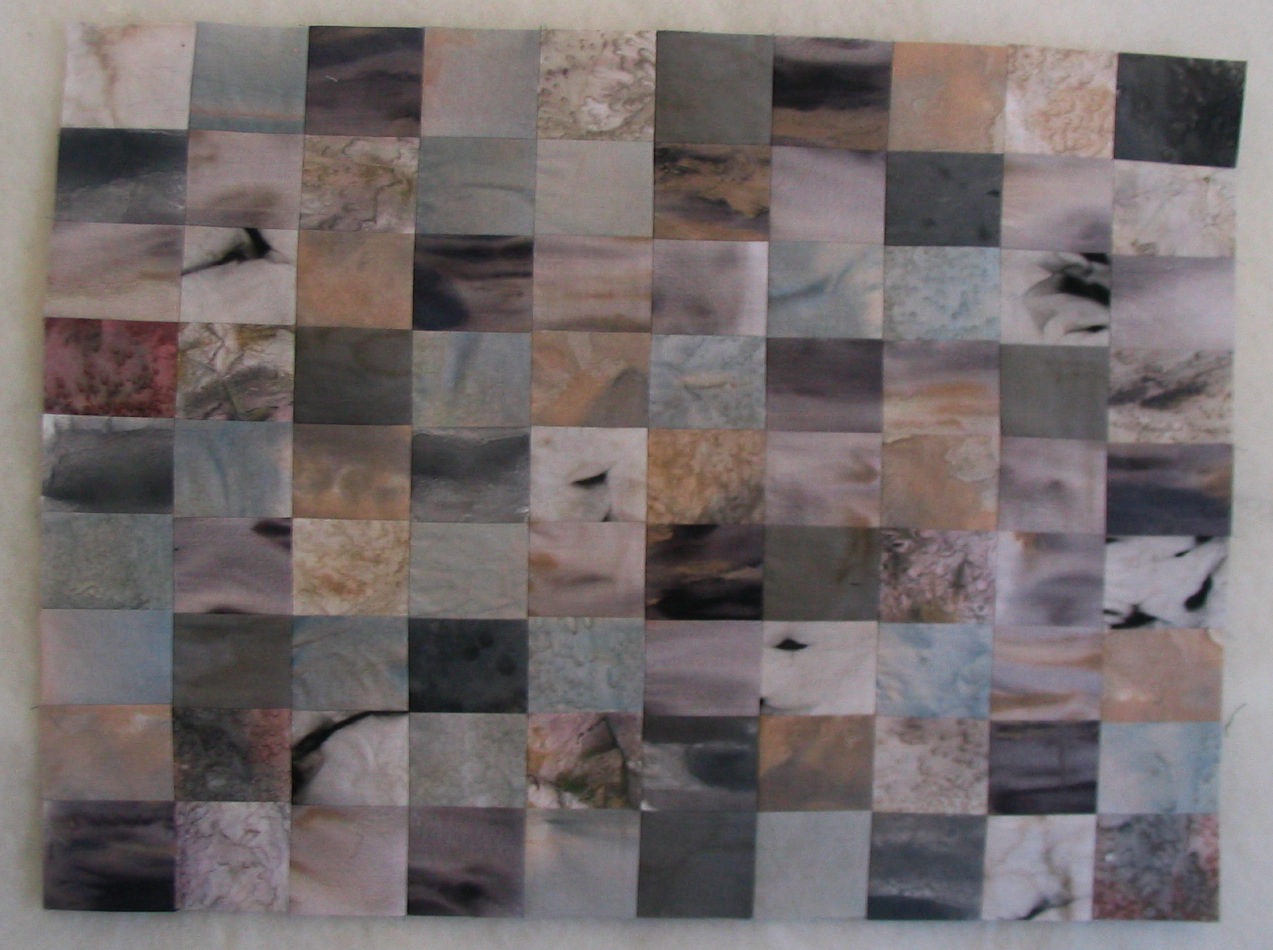
(each about 11x14") |
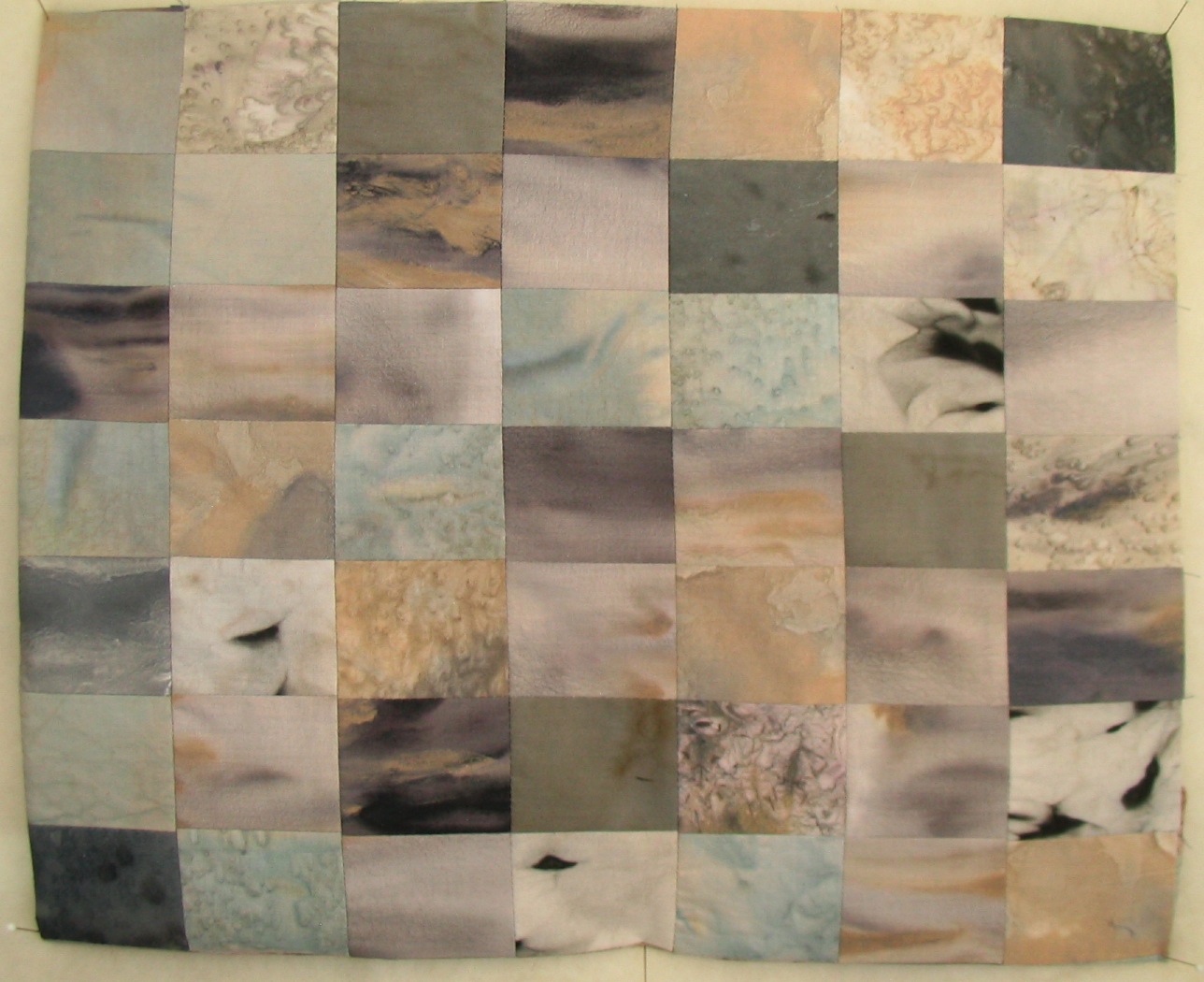 |
When I was doing the quilting, the slanted
lines called to my mind rays of light in a forest, and I realized that
this quilt was related in color and feeling to the Pine Grove idea I
had put away from Design Camp.
I pulled out
the rest of the rectangles and did a more improvisational piece.
(about 67x70")
For the back of the quilt, I
wanted to use up more of the uncut leftover fabric, and to give a home
to some stone blocks that I had appliquéd and set aside.
I sliced up some of those blocks into
strips—I really like how this worked out.
In the background of all this, since 2006 I've been planning and then
working on another major quilt. The quilt is not yet finished, but here is the top, in
progress. (Each tier of color is completed, but the four tiers are not yet sewn together.)
(about 60x64")
As I worked on the quilt
about Loss, I found myself thinking something like: "Without
Jeremy, the future for David and me is unremitting blackness, but I
don't want to think of Jeremy's future--his existence, of whatever
possible nature it might be--as this same blackness." If someone
asked me "Do you believe in life after death?" and asked for a yes or
no answer, the closest answer would be "no." And yet, when David
and I had to find words for the marker on Jeremy's grave, we chose this
epitaph, whose words are drawn from the Jewish funeral service:
May he find refuge forever
In the shelter of Your wings
And may his soul be bound up
In the bond of eternal life.
I couldn't say that I "believe" in these words, but I need their comfort.
The quilt in progress is about the metaphor of "the shelter of
your wings." When I first thought about this, a Durer watercolor
came to mind--the wing of a roller bird:
I thought
that Durer's colors might be a starting point also. The range of
blues from royal to aqua struck a chord, and the orange and black also
seemed good. In contrast to the straight lines used in "Loss," this
image demanded curves. For months I
sketched different combinations of curved lines and made many small
maquettes, using the four colors (and sometimes others) in various
combinations.
While the color black as used in the "Loss" quilt
signals emptiness and bleakness, here it carries a different meaning,
that of protection and warmth. It also calls up another image of
divine protection used in the Psalms: "in the shadow of Your
wings." Here are some details that show the construction process.
In the years that I worked on the plan for this quilt, I was interested
to see echos of my choices in other places. The curved
line as a sheltering image, which I took from the bend of a wing, is
also called up in the late medieval image of the Madonna of mercy,
something I remembered from my years as a medievalist:
|

Simone Martine, 1308-10
|
Piero Della Francesca, 1445
|
The color
combination I used in this quilt is also something I've noticed elsewhere.
When in China in 2007, I was struck by the standard
colors used in Ming architecture.
I've also been entranced by
Gina Franco's photographic images using orange and blue, some of which
have a similar color scheme of blue/aqua/orangey-red/and black:
When at the Art Institute earlier this
month, I noticed the same colors in some of Matisse's paintings:
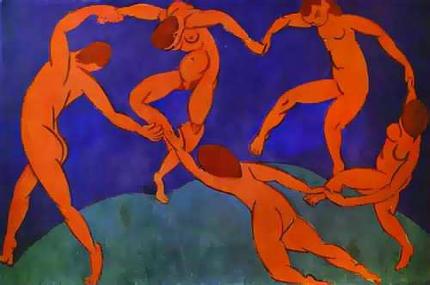
Matisse, Dance
|
Matisse, Woman on a High Stool
|
And—totally
unplanned—my four books, two orange and two blue.
It's been five years now since I dismantled my study, but it has taken
me a long while to use the word "studio" for the room in which I work
on quilts. It's been easier to call it my "sewing room."
When I started a blog about my quilting in January of
2009, I called it "Studio Notes," partly as a way to accustom
myself to using the term. But if the room is a studio, then I am
claiming to be an artist. "When can a person legitimately call
themselves an artist?" Here is one artist's answer: "When you find
that making art is at the center of your life, then you can
legitimately call yourself an artist. Most artists make their
work because they are driven to make art; their level of dedication to
their life's work is very high and holds a sacred place in their
being." According to this definition, I qualify. The
central—even sacred--place that scholarship used to have in my
life is now occupied by art.
Two different paths have led to this life of art—one from
scholarship and one from craft. The clearest path would seem to
be from craft, as the making of quilts developed out of my making of
other things, and I began quilting as an extension of this craft
life. I still love making this kind of quilt, quilts in which I
begin with an already established pattern, which I then interpret with
my own choices, primarily of color.
Here are some examples: First, from a traditional Amish
pattern of "Roman Stripes," I used the variation on the right
from Roberta Horton, An Amish Adventure, 2nd edition (C&T Publishing, 1996), p. 35.
to make this quilt for a young friend, Luke Matthew:
Here's a pattern for "Four-Patch Stacked Posie" and a few of the quilts I've made with the pattern:
And here's a simple zig-zag pattern:

pattern by Amanda Jean of Crazy Mom Quilts |
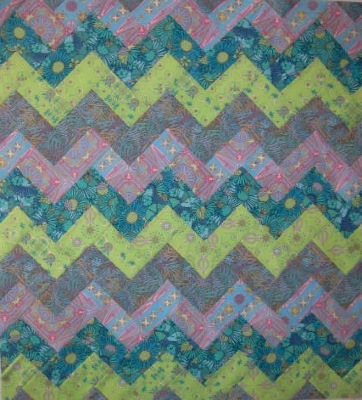
my first version, fairly close in feel (about 32x40") |
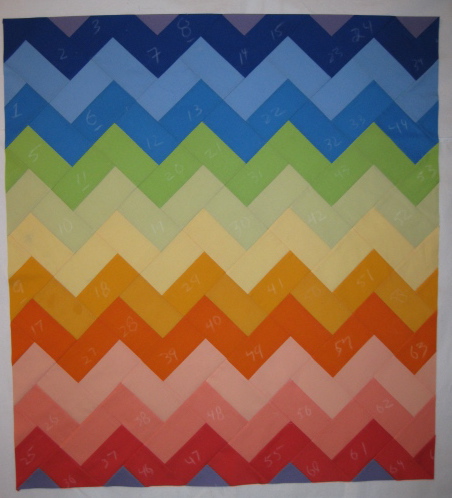
and a second version done in solids
|
After trimming the edges of the last quilt, I had some pieced scraps
left over. Playing with those scraps, I came up with this piece (12x12"),
which I would put in the border between art and
craft. It was not done according to someone else's pattern, but
it was done without any underlying purpose or idea—just for the
fun of arranging shapes and color.
The quilts that function in my life as art, are those formed not from
someone else's pattern, and not for the main pleasure of manipulating
the materials, but those that come from a personal need—an idea
or emotion that is preoccupying me, that is disturbing me.
Although many artists work in response to the natural, physical world,
others work from the inside out. I am not responding to the
material world outside of me, but bringing out into material the world
inside me. Even the landscape pastel, done after taking many
photos of late winter farmland, was done without reference to the
photos, and ended up in the same palette that I chose for the Pine
Grove quilts—a palette that matches neither fields or forest, but
the feeling of quiet and stillness that I was seeking out as a respite
from my grief.
And
although it didn't occur to me until writing this talk, the very
different palette used for Loss is closely related to the colors I
chose for Shelter.
Although
different in intent, the quilts are bound together by the originating
motive of response to Jeremy's death.
This perhaps helps explain how I see my art as more closely connected
to my scholarship than to my years of knitting sweaters and
afghans. My scholarship also came from issues close to my heart,
issues that I was struggling with and wanted to resolve. The
issues were complex and difficult, and it took me years of work to
reach the understanding that I sought. The first book helped me
live as a woman amongst conflicting desires and demands, the second
book helped me live as a Jew. The quilts have helped me live as a
person who has lost a child. They have helped me live with grief
and guilt.
The feeling of inner drive is similar, and the scope and seriousness of
a book and one of these big quilt projects are also similar; they are
both work, not play. But the scholarship comes from a question
and ends with an answer. The quilts, on the other hand, come from
an emotion and end with expression. The life of the work once
it is complete is also very different. Much as the scholarship was
initiated and sustained from an inner drive, it was also intended for a
wide audience, and the writing and revisions were done with readers in
mind. The quilts are done for me. I have seen that others
respond to them too, and I am glad of that, but I am not making them
for an audience. I would never sell one of these quilts.
The extent to which this work is deeply self-centered is unsettling to
me, and a case can certainly be made that art should not be done as a
kind of therapy to work out one’s own problems—rather, the
purpose of art should extend outwards, to affect others. But for
me, the art has been therapy. It has enabled me to stumble, to
creep, back into life, to see further into the future than just the
next hour. It has provided me a way to live with grief. If
others are also moved by what I have created, that is good. If
the work helps someone understand the rupture and persistence of loss,
that's good. If it helps someone understand that for many people,
beneath the surface may be concerns or issues you cannot see, but
that are determining factors in that person's life, that's good
too. Though it was not my intent to communicate with others, the
fact is that my experience and feelings are not unique, and art that
embodies my experience can build a bridge to others. In this way,
perhaps I fulfill what Roger Sessions sees as the human responsibility
of the artist: "above all [the] awareness of the human condition,
a common involvement and a common stake in it" [Questions about Music (1970), 166].
There's more I could say about the processes of making scholarship,
making art, and the ways in which the habits/methods I've learned in
research and writing have also served me in the making of art.
Just briefly, here are some of the things I learned from doing
scholarship that have also helped me in making art:
-
the need for persistence, especially when you're ready to give up;
-
building a unified big-picture out of scattered fragments;
-
how to organize a work process, and how to get things done, even with limited time;
-
how to know when you're done, and how to know if the work is good;
-
the importance of talking with others about work
in progress—to share the work in a community, even while most of
the work is done in solitude.
And yet, despite the similarity of originating impulse/drive and in the
production of the work, the thing worked on is so different. The book, though it took much longer to
complete is so much smaller, and is so much more difficult to respond
to—you have to spend hours reading it, while the quilt can be taken in with one extended look.
When scholars run into each other, the standard question is "What are
you working on?" For many years I loved answering that question and the
exchange that would follow, catching up with friends and colleagues
about our scholarship. Now when I am asked that question by
another scholar, my answer can only be, "I've stopped doing
scholarship." This is another kind of loss for me—the loss
of the sense of belonging to a large, widespread community of
scholars. It also disrupted my job at Knox, and is part of the
reason I went to part-time status, eliminating the part of my work-time
that would have been devoted to research. On the other
hand, if an artist asks me the question, "What are you working on?"
then it is a question I can answer. I am grateful to have found
this path into art. I would give it up in an instant if I could
have Jeremy back. But he is gone, and art has helped me live
without him.
When people visit my studio they often ask me about the maquette pinned
to the upper right corner of the bulletin board.
 |
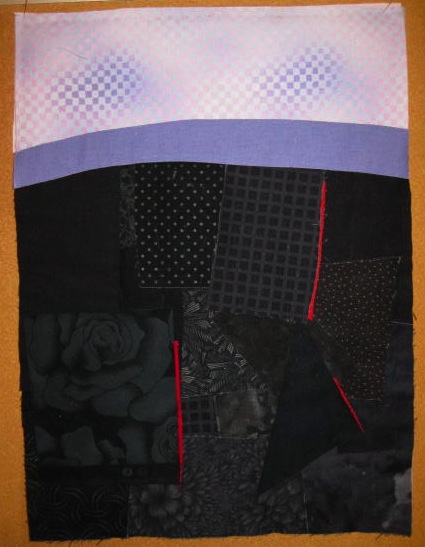
(about 12x14") |
This maquette is for a quilt I was thinking of
several years ago, a self-portrait to be called "Beneath the
Surface." Not beneath the ground, as for Peter's quilt, but
beneath the surface of my everyday interactions with people. The
lavendar strip represents the calm appearance that I present to the
world, while underneath is the blackness of grief, lanced from time to
time by the anguish that pierces without warning. So many around
us hold beneath the surface some agony unknown to the rest of us.
As said by Philo of Alexandria, 2,000 years ago:
"Be kind, for everyone is fighting a great battle."
In closing, I would like to thank some of the many people who have
helped me along this new path. Thanks to the art faculty at Knox,
who have been exceptionally supportive from the time that I began
working on the Loss quilt--providing critiques of my work, allowing me
to sit in on classes, and just talking with me as though I were an
artist. Thank you Lynette, Tony, Mark, Claire and Rick for this
generous response to my work as serious and of consequence. The
support and critique of my quilting friends has also been crucial (with
special thanks to Mary Beth, Louise, and all the other Design Campers),
as has been the gifted teaching of Bill and Weeks. Finally,
thanks to David,
always and ever, my companion in love and in grief.
If you would like to look at a website created in memory of Jeremy, click here.
If you would like read more about my quilts in progress, you can follow my blog, "Studio Notes."


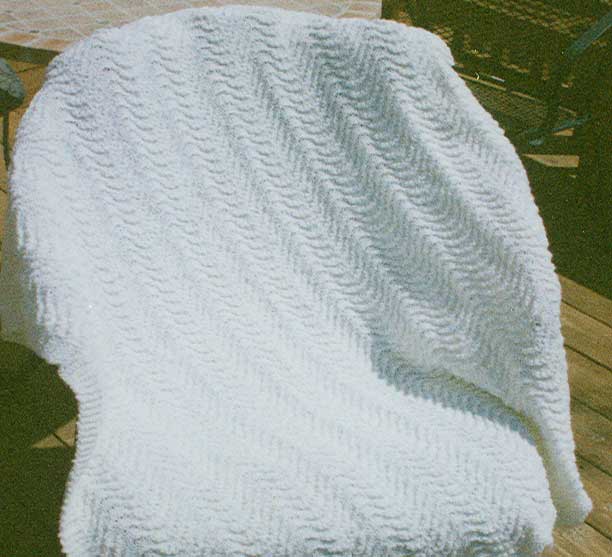
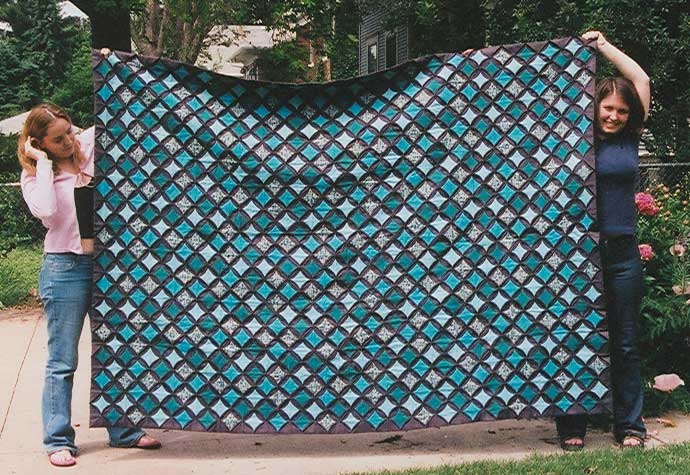
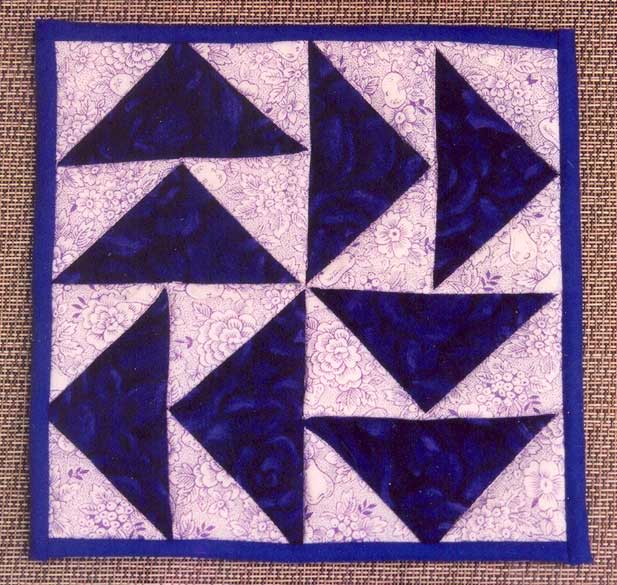
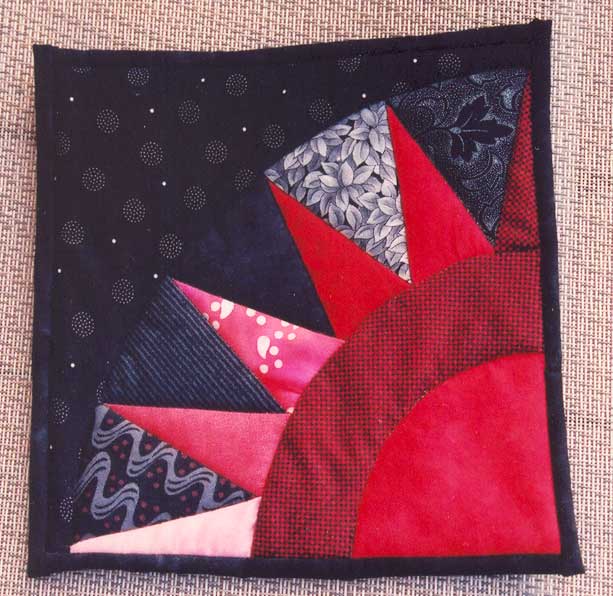
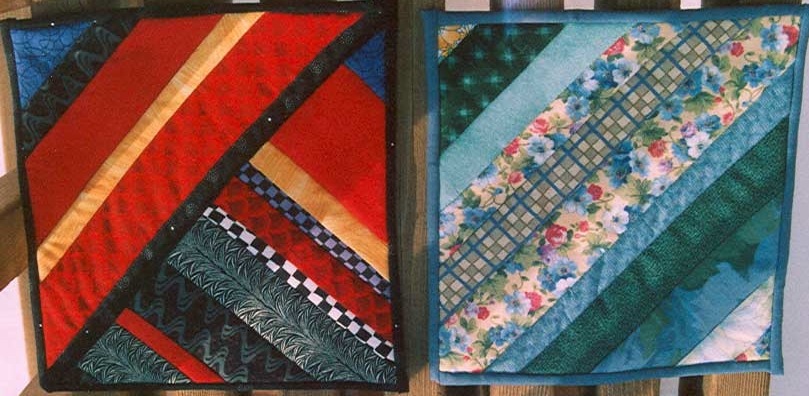
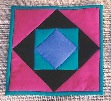
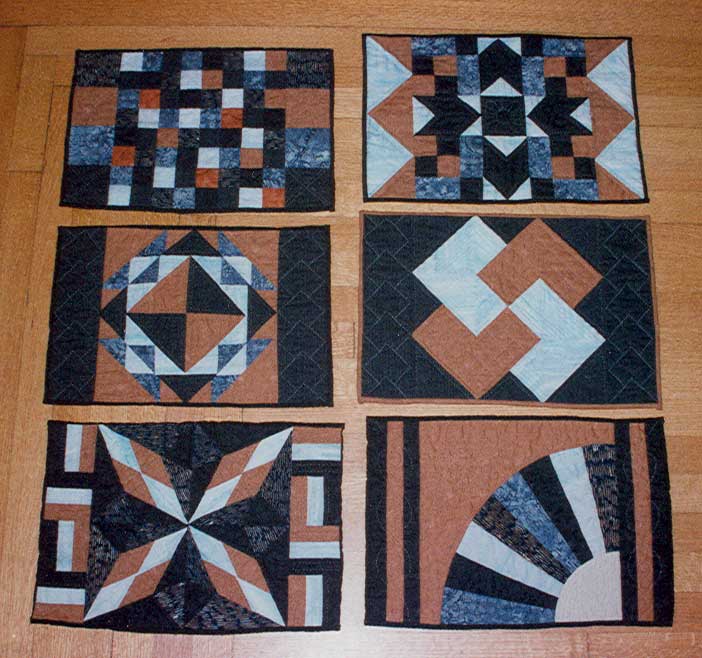
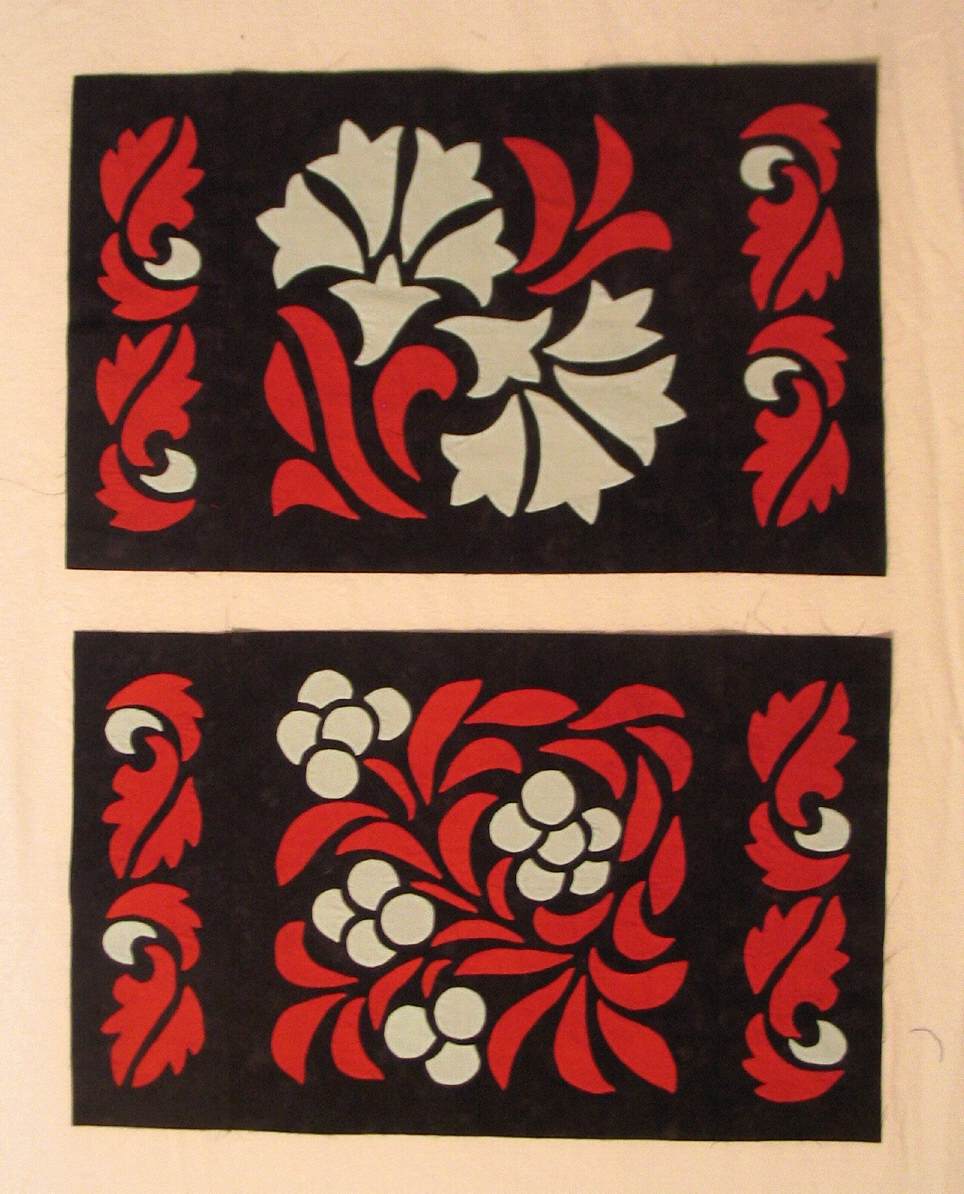

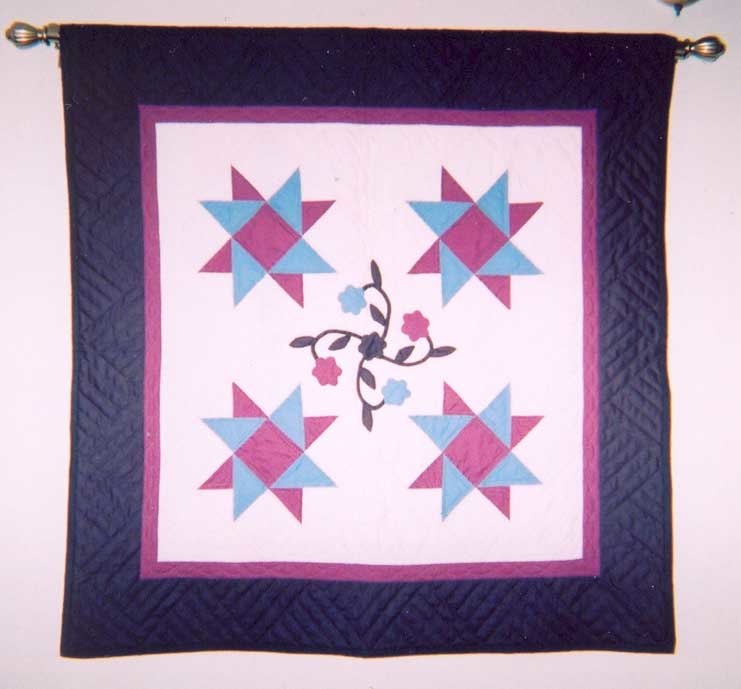

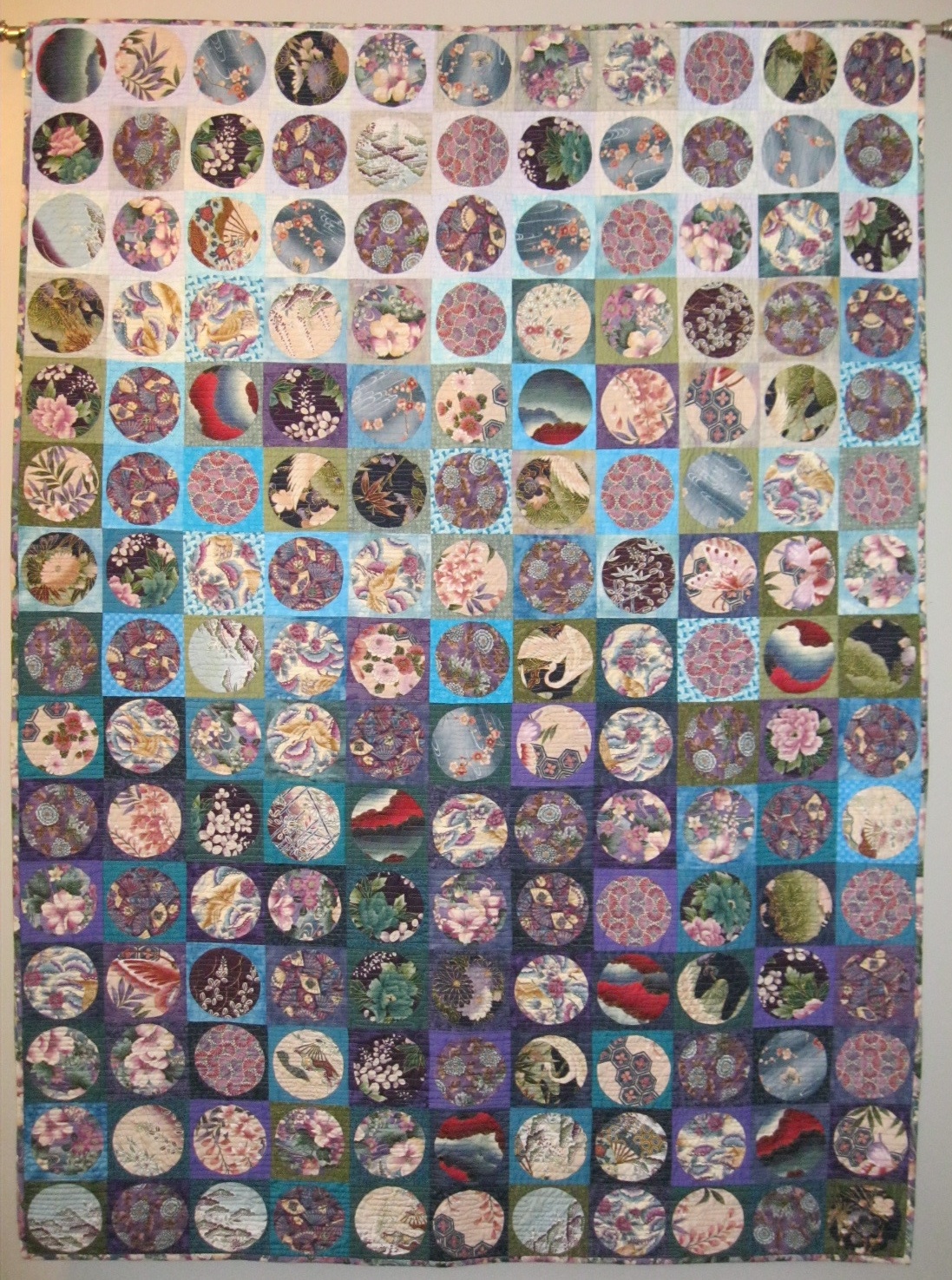
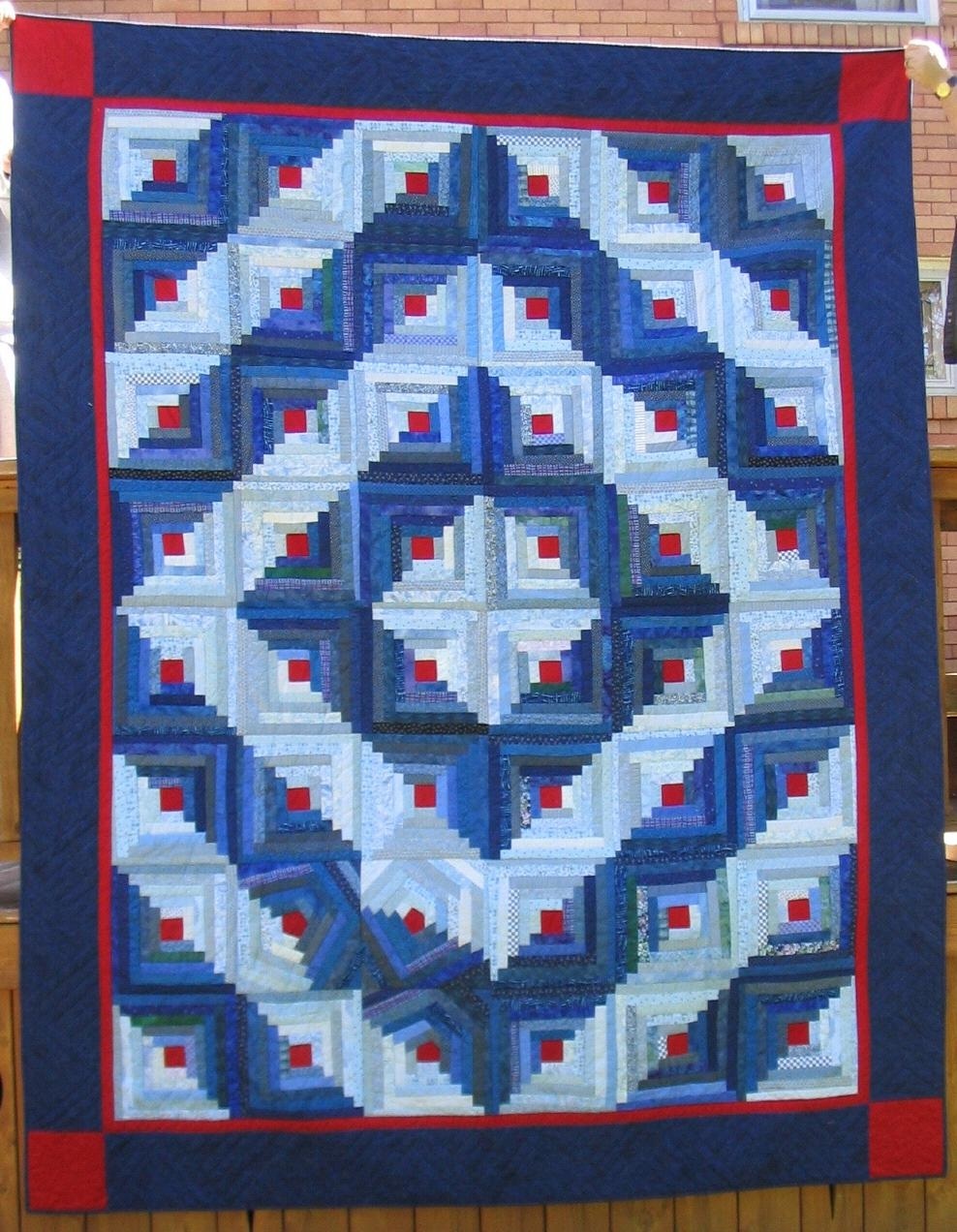

 I was disappointed—even disgusted. I wanted
to do something that was totally abstract, that conveyed the peace and
quiet of the place without reference to specific objects like the
trees, shore, and water. But I had no idea how to do it.
When Bill came by to see how things were going, I was so upset with the
inadequacy of what I had done that I could barely speak, and I sent him
away. Once I composed myself, he came around again, and got me to
talk about the place, about what it was I wanted to convey. He
then asked me, "What was the opposite of that place?" I answered
that it was the hustle and bustle of all the group activities of the
camp—lots of things going on with lots of people. "Make a
maquette of that," he said. So I did.
I was disappointed—even disgusted. I wanted
to do something that was totally abstract, that conveyed the peace and
quiet of the place without reference to specific objects like the
trees, shore, and water. But I had no idea how to do it.
When Bill came by to see how things were going, I was so upset with the
inadequacy of what I had done that I could barely speak, and I sent him
away. Once I composed myself, he came around again, and got me to
talk about the place, about what it was I wanted to convey. He
then asked me, "What was the opposite of that place?" I answered
that it was the hustle and bustle of all the group activities of the
camp—lots of things going on with lots of people. "Make a
maquette of that," he said. So I did. 

 But there were still many questions of size, scale and
method. For example, just on the issue of how to sew the small
colored pieces onto the strip: Definitely by hand rather than
machine, but should the edges be raw or turned under? If raw,
should I allow the edges to fray? How big should the pieces
be? How much should they overlap, if at all? In the past, I would have been frustrated by all these
decisions--frustrated that I didn't know the "right" answer, not
knowing what would look best, and that I didn't know how to figure it
out. But with this project, I felt entirely
different. I was content to just keep at it until I had a method
that felt right.
But there were still many questions of size, scale and
method. For example, just on the issue of how to sew the small
colored pieces onto the strip: Definitely by hand rather than
machine, but should the edges be raw or turned under? If raw,
should I allow the edges to fray? How big should the pieces
be? How much should they overlap, if at all? In the past, I would have been frustrated by all these
decisions--frustrated that I didn't know the "right" answer, not
knowing what would look best, and that I didn't know how to figure it
out. But with this project, I felt entirely
different. I was content to just keep at it until I had a method
that felt right. 
